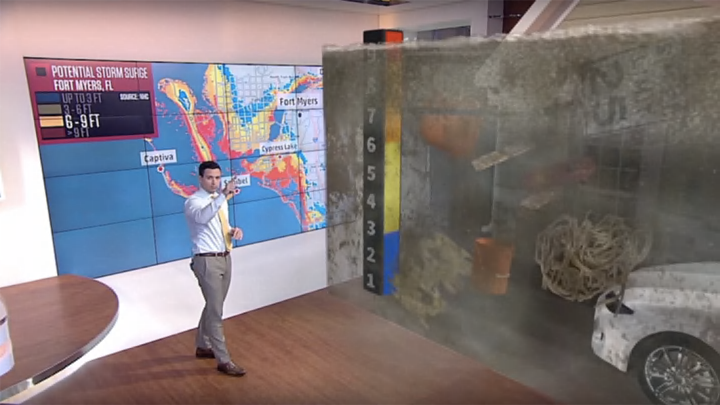The Weather Channel has been the public face of weather in the United States for decades. From the moment they flipped the switch on their first graphic of Mount Rushmore sweating in a heat wave, the network has transfixed us with its coverage of every major storm to strike the country since the early 1980s. As technology advances, so too does their ability to put us square in the elements. Now, not only do they send their meteorologists out into the weather to show us what it’s like out there, but they can recreate the weather for us right in their Atlanta studios with their augmented reality technology.
The network’s latest augmented reality presentation gives viewers an up-close visualization of a hurricane’s storm surge in relation to everyday objects in order to drive home the danger of this deadly phenomenon. The Weather Channel’s hurricane expert Michael Lowry recently used the technology, called SurgeFX, to virtually flood the studio with dirty, debris-filled water and demonstrate to viewers what three feet, six feet, and more than nine feet of storm surge flooding would look like at your home.
A storm surge is the sea water that’s pushed inland by a tropical cyclone’s winds. Storm surges in the most intense hurricanes can inundate areas near the coast with more than a dozen feet of water, and the strongest surges can push several miles inland. The majority of deaths that occur during a hurricane are the result of people drowning in the storm surge.
Augmented reality presentations became a regular part of the television channel’s lineup back in May 2015 when meteorologist Jim Cantore introduced a virtual walkthrough of the formation of a tornado. The network creates the realistic simulations in-house and displays them with the help of tracking technology from Ncam, which allows the virtual displays to remain in one spot in the studio while the cameras and presenters move around to show viewers different points of interest.
The simulations range from towering thunderstorms to a large globe that rises from the floor of The Lab—a high-tech studio that serves as the Weather.com nerve center for severe weather coverage—which can display current weather and forecast events.
In the year since the augmented reality segments were introduced, The Weather Channel has taken us on a tour of the U.S. Air Force’s Hurricane Hunters aircraft, the anatomy of a lightning strike, how hailstones form in a thunderstorm, and how different types of precipitation form in a winter storm.
